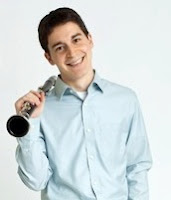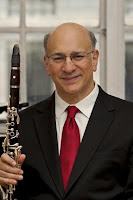The most recent video from rising clarinet star, Andrew Moses. This video shows off his skills even better than the other. This kid has the potential to do amazing things.
Andrew Moses (age 11), "I Got Rhythm"
Wednesday, May 25, 2011
Juilliard Commencement Speech
Juilliard Commencement Speech
Tuesday, May 24, 2011
Clarinet Factory: A Clarinet Quartet Thinking Outside the Box
A clarinet quartet is a group usually consisting of three soprano clarinets and a bass clarinet; an ensemble weird enough in the classical world. Even stranger, though, is taking that group and mixing it with drums, electronics, singing, and other effects and instruments. The result is Clarinet Factory. This group of four, classically trained clarinetists is experimenting with different ways to play the clarinet. Whether they are imitating the sound of other instruments through the clarinet or adding didgeridoos and percussion, they are always looking for something different to experiment with. Check out their music. They have some really interesting stuff ranging from haunting melodies to dancelike beats.
Monday, May 23, 2011
OsbornMusic.com : Information for Players of Every Level
Sean Osborn, former clarinetist with the Metropolitan Opera Orchestra and graduate of the Curtis Institute of music, runs a very handy website. On it you will find many things such as Sean's bio, schedule, discography, etc., but the part of the site I want to focus on is his "Educational" section. Here you will find warmups, technique studies, legato exercises, an orchestral excerpt guide and more, all with written instructions and tips from Sean. I have found myself using this site many times for warm up ideas and help with phrasing. I haven't even begun to go through all of the information avaliable there. If you are ever bored, frustrated, or feeling uninspired, check out his site!
List of Principal Clarinet Player (part 3)
Bachelor's, University of Northern Colorado, Master's at Northwestern University with Robert Marcellus.
Escuela Libre de Música, Cincinnati College-Conservatory, Artist Diploma,
Indiana University
Oregon Symphony Orchestra - Yoshinori Nakao
Philadelphia Symphony Orchestra - Ricardo Morales
Escuela Libre de Música, Cincinnati College-Conservatory, Artist Diploma,
Indiana University
Phoenix Symphony Orchestra - Alexander Laing
Northwestern Univsersity; Master's, Manhattan School of Music; artist's diploma, Sweelinck Conservatorium Amsterdam
Pittsburg Symphony Orchestra - Michael Rusinek, Thomas Thompson (co-principal)
Began studies at the Royal Conservatory of Music with Avrahm Galper; The Curtis Institute of Music
American Conservatory of Music; Northwestern University; addition private studies with Jerome Stowell, Robert Marcellus and Clark Brody
Rochester Philharmonic - Kenneth Grant
Eastman School of Music
San Antonio Symphony Orchestra - Illya Shterenberg
Began his music studies at Kosenko Music College in Zhitomir; Artist Diploma, Southern Methodist University; Some further study at Depaul University
San Diego Symphony Orchestra - Sheryl Renk
San Francisco State University; San Francisco Conservatory with Donald Carroll
San Francisco Symphony Orchestra - Carey Bell
University of Michigan at Ann Arbor; Continued studies at DePaul University with Larry Combs
San Francisco Opera Orchestra - Jose Granero
Bachelor's, Granada Superior Conservatory (Spain); G. Verdi Conservatory (Italy); University of Southern California and The Colburn School with Yehuda Gilad
San Francisco Ballet Orchestra - Jose Granero (acting principal)
Bachelor's, Granada Superior Conservatory (Spain); G. Verdi Conservatory (Italy); University of Southern California and The Colburn School with Yehuda Gilad
St. Paul Chamber Orchestra - Timothy Paradise
Pomona College; Yale University; Staatliche Hochschule für Musik in Munich
St. Louis Symphony Orchestra - Scott Andrews
New England Conservatory with Harold Wright
Utah Symphony Orchestra - Tad Calcara
Manhattan School of Music; San Francisco Conservatory; Cleveland Institute of Music
Monday, May 16, 2011
What Excerpts do I need to Know? (band auditions)
For those of you pursuing clarinet performance, you are sure to encounter an audition some day. What kind of rep do you need to know? Well, it will always vary, but there are some staples of each. Below are some examples of rep for band auditions, with orchestral rep in the previous post.
Pershing's Own Army Band, B-flat Clarinet Rep (as of January 12, 2009)
(rep can be downloaded here)
Concerto No. 2 - C.M. Weber
A Midsummer Night's Dream, Scherzo - Felix Mendelssohn
The Rifle Regiment March - Sousa
Elsa's Procession to the Cathedral - R. Wagner
Prince Igor - Borodin
Pineapple Poll - Sullivan
William Tell Overture - Rossini
Russlan and Ludmilla - Glinka
Blue Shades - Ticheli
Aegean Festival Overture - Makris
Sonata No. 2 - G.P. Telemann
What Excerpts do I need to Know? (orchestral auditions)
For those of you pursuing clarinet performance, you are sure to encounter an audition some day. What kind of rep do you need to know? Well, it will always vary, but there are some staples of each. Below are some examples of rep for orchestral auditions, with band rep to come in the following post.
Chicago Symphony Orchestra Principal Clarinet Auditions (as of May 16, 2011)
(rep can be downloaded here)
Concerto for Orchestra - Bartók
The Miraculous Mandarin - Bartók
Dances of Galanta - Kodály
Pines of Rome - Respighi
Symphony No. 1 - Shostakovich
Symphony No. 9 - Shostakovich
Petrushka - Stravinsky
Knoxville Symphony Orchestra Principal Clarinet Auditions (as of May 16, 2011)
(more detailed list available here)
SOLO PIECE
Mozart Clarinet Concerto, First Movement
FIRST CLARINET EXCERPTS
Symphony No. 6 - Beethoven
Symphony No. 8 - Beethoven
Midsummer Nights Dream, Scherzo - Mendelssohn
Scheherazade - Rimsky Korsakov
Capriccio espagnol - Rimsky Korsakov
Symphony No. 3 - Brahms
Concerto for Orchestra - Bartók
Symphony No. 2 - Rachmaninoff
Daphnes et Chloe Suite II - Ravel
Peter and the Wolf - Prokofiev
Pines of Rome - Respighi
Symphony No. 9 - Shostakovich
Dances of Galanta - Kodály
Rhapsody in Blue - Gershwin
Saturday, May 14, 2011
List of Principal Clarinet Players (part 2)
Ft. Worth Symphony Orchestra - Ana Victoria Luperi
The Curtis Institute of Music with Donald Montanaro
Grant Park Symphony Orchestra - Charlene Zimmerman
Northwestern University
Houston Symphony Orchestra - David Peck
University of Southern California
Indianapolis Symphony Orchestra - David A. Bellman
The Eastman School of Music with Stanley Hasty and Northwestern University with Larry Combs.
Jacksonville Symphony Orchestra - Peter Wright
BME, Jacksonville University, MM, The Eastman School of Music
Kansas City Symphony Orchestra - Raymond Santos
University of Southern California with Yehuda Gilad and Monica Kaenzig

Kennedy Center Opera House Orchestra - (Unknown) Send us an email if you know who it is!
Los Angeles Philharmonic - Michele Zukovsky and Lorin Levee

Studied with her father, former LA Phil principal clarinetist, Kalman Bloch
DePaul University
Louisville Symphony Orchestra - Andrea Levine
The Eastman School of Music with Kenneth Grant, The Cleveland Institute with Franklin Cohen
Metropolitan Opera Orchestra - Anthony McGill and Stephen Williamson
The Curtis Institute of Music
BM, Performer's Certificate, The Eastman School of Music, MM, The Juilliard School
Milwaukee Symphony Orchestra - Todd Levy
BM, The Curtis Institute of Music
The Curtis Institute of Music
Carnegie-Mellon University with Jerome Levine, MM, New England Conservatory with Peter Hadcock
Bachelors in music and linguistics, Harvard, was pursuing graduate studies at the University of Southern California when he won the position.
Nashville Symphony Orchestra - James Zimmerman
BM, University of Southern California with Yehuda Gilad, MM, University of Minnesota with Burt Hara.
National Symphony Orchestra - Loren Kitt
New Jersey Symphony Orchestra - Karl Herman
North Carolina Symphony Orchestra - Andrew Lowy
New York City Ballet Orchestra - Steven Hartman
The Julliard School with Augustin Duqués, after Juilliard he continued private studies with Kalmen Opperman
New York City Opera Orchestra - Laura Flax
BM and MM, the Julliard School with Augustin Duqués and Leon Russianoff
Friday, May 13, 2011
Anthony McGill Plays Mozart for Corona Children
The Corona Youth Music Project is a wonderful program in Queens, New York. It offers free music programs for youth in the form of after school programs, seminars, and camps. Corona supports a children's orchestra and a choir along with instrumental and musicianship lessons.
"It serves the neighborhood by providing a safe, fun place for children to develop discipline, persistence, and self-esteem through music, and become productive valued members of society."
- The Project, Corona website
This video is of Anthony McGill performing the Mozart Clarinet Concerto for a group of children at Corona. I find it inspiring and moving to see a musician reaching out like this. I thought you guys might enjoy it.
"It serves the neighborhood by providing a safe, fun place for children to develop discipline, persistence, and self-esteem through music, and become productive valued members of society."
- The Project, Corona website
This video is of Anthony McGill performing the Mozart Clarinet Concerto for a group of children at Corona. I find it inspiring and moving to see a musician reaching out like this. I thought you guys might enjoy it.
Wednesday, May 11, 2011
Detroit Symphony Advertisement
The Detroit Symphony apparently put together a great advertising campaign, but in light of recent financial issues and strikes, can not afford to put them out there. Here is one of their videos. I think it is a great advertisement, it's just too bad it could not be aired.
How to Kill Orchestras - An article by Bernard Holland of the NYTimes
How to Kill Orchestras - Bernard Holland
Syracuse Symphony Files for Chapter 7 Bankruptcy
Syracuse Symphony Orchestra: A Message from Paul Brooks, Interim Executive Director and Rocco Mangano, Chair, Board of Trustees, Syracuse Symphony Orchestra
Read more at Syracuse.com
Subscribe to:
Posts (Atom)






































